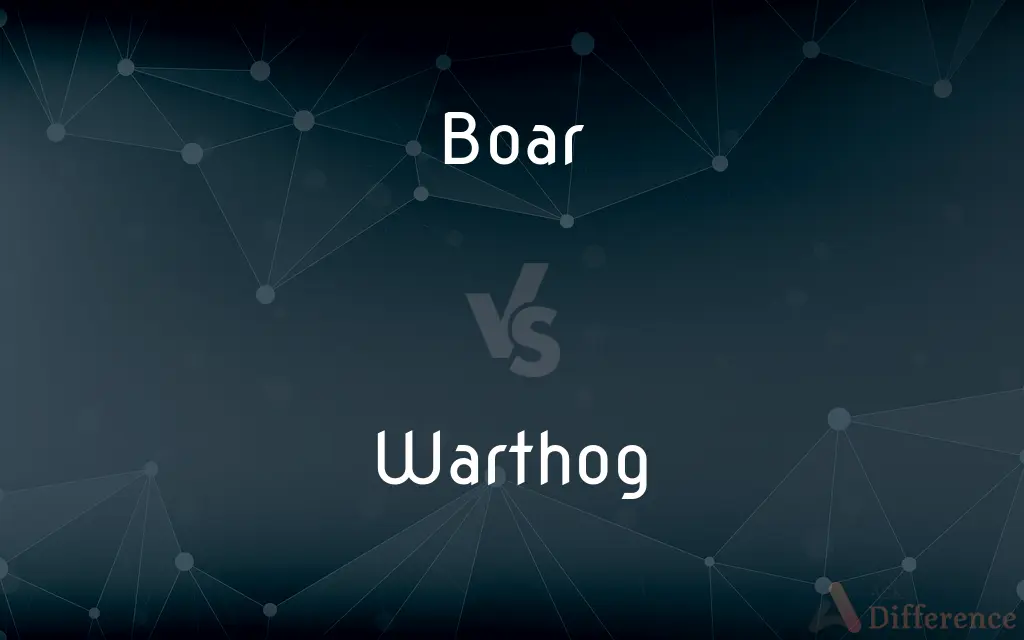Boar vs. Warthog — What's the Difference?
By Fiza Rafique & Maham Liaqat — Updated on March 16, 2024
Boars are wild pigs of the genus Sus, adaptable and widespread, while warthogs are African wild pigs, known for their distinctive tusks and warts.

Difference Between Boar and Warthog
Table of Contents
ADVERTISEMENT
Key Differences
Boars, belonging to the genus Sus, are versatile and widespread animals found in various environments across Eurasia and North Africa. They are known for their robust bodies, relatively short legs, and long snouts, which are used for foraging. Warthogs, native to Africa, are easily recognized by their large curved tusks, distinct facial "warts," and relatively longer legs adapted for running in open terrain.
While boars have a more uniform, dark bristle-covered coat, warthogs possess a sparser covering of hair and prominent mane that runs along the spine. This difference in appearance reflects their adaptation to different habitats and climates. Warthogs are also known for their habit of kneeling on their front knees to eat and for burrowing into the ground to escape predators or extreme weather.
Boars are more solitary or live in smaller family groups known as sounders, primarily nocturnal to avoid human interaction. Warthogs, however, are more social, often seen in groups called sounders, and are diurnal, taking advantage of the warmth of the sun due to their sparse hair covering.
In terms of diet, both boars and warthogs are omnivorous, with boars having a diet that includes a variety of plants, roots, fruits, and small animals. Warthogs, on the other hand, have a more specialized diet that can include grasses, roots, berries, and occasionally carrion. Their adaptation to grazing is facilitated by their ability to kneel on their front legs, allowing them to access low-growing vegetation.
Despite these differences, boars and warthogs share common challenges, including habitat loss and conflicts with humans. However, their adaptability and generalist feeding habits have allowed them to survive in a range of environments.
ADVERTISEMENT
Comparison Chart
Habitat
Eurasia and North Africa
Africa
Appearance
Dark, bristly coat; short legs
Large tusks, facial warts; longer legs
Social Behavior
Solitary/small groups; nocturnal
Social; diurnal
Diet
Omnivorous: plants, roots, small animals
Primarily grasses, roots; kneels to eat
Adaptations
Foraging with long snout
Kneeling to graze; burrowing for shelter
Compare with Definitions
Boar
Thrives in diverse environments, from forests to agricultural lands.
Boars in forests adapt by foraging for diverse foods.
Warthog
Notable for their large tusks and facial "warts."
Warthogs use their tusks for defense and digging.
Boar
Generally solitary or in small family groups.
A sounder of boars often includes a female and her offspring.
Warthog
Suited for life in open areas and savannas.
The longer legs of warthogs aid in escaping predators in open habitats.
Boar
Often comes into conflict with humans due to habitat overlap.
Boars searching for food can enter human settlements, leading to conflicts.
Warthog
Forms groups and active during the day.
Warthog sounders are often seen basking in the sun.
Boar
Characterized by a robust body and dark, dense bristles.
The dense bristles of boars provide insulation in colder climates.
Warthog
Primarily grazers, with a unique kneeling posture.
Kneeling allows warthogs to reach low vegetation.
Boar
Feeds on a wide range of foods.
Boars can cause damage to crops due to their varied diet.
Warthog
Uses burrows for shelter and protection.
Warthogs can occupy abandoned burrows or dig new ones for safety.
Boar
A tusked Eurasian wild pig from which domestic pigs are descended, exterminated in Britain in the 17th century.
Warthog
Either of two wild African hogs (Phacochoerus africanus or P. aethiopicus), having two pairs of curved tusks and wartlike growths on the face.
Boar
An uncastrated domestic male pig.
Warthog
(zoology) A wild pig of the genus Phacochoerus, native to Africa.
Boar
The wild boar.
Warthog
(military) A nickname for the A-10 Thunderbolt II air support warplane
Boar
An uncastrated male pig.
Warthog
African wild swine with warty protuberances on the face and large protruding tusks
Boar
A wild boar (Sus scrofa), the wild ancestor of the domesticated pig.
Boar
A male pig.
Boar
A male boar (sense 1).
Boar
A male bear.
Boar
A male guinea pig.
Boar
The uncastrated male of swine; specifically, the wild hog.
Boar
Old World wild swine having a narrow body and prominent tusks from which most domestic swine come; introduced in United States
Boar
An uncastrated male hog
Common Curiosities
Are warthogs aggressive?
Warthogs can be aggressive when threatened, but they usually prefer to flee from danger.
Which is larger, a boar or a warthog?
Boars can vary greatly in size, but some can be larger than warthogs, which typically weigh up to 250 pounds.
What predators do boars have?
Large predators like wolves, tigers, and humans are among the main predators of boars.
Are warthogs solitary animals?
No, warthogs are quite social and often found in family groups known as sounders.
What is the social structure of a boar sounder?
A boar sounder typically consists of females and their young, while males are often solitary or form bachelor groups.
How fast can a warthog run?
Warthogs are surprisingly fast and agile, capable of running up to 30 mph to escape predators.
Can boars and warthogs interbreed?
No, they are different species with enough genetic differences to prevent interbreeding.
How do boars affect the environment?
Boars can impact ecosystems by rooting up soil and vegetation, which can lead to erosion and disrupt local flora and fauna.
What is the lifespan of a boar?
Wild boars can live up to 20 years, but this can vary depending on environmental factors and predation.
Do warthogs really kneel to eat?
Yes, warthogs are known to kneel on their padded front knees to reach low-growing vegetation.
Are warthogs endangered?
Warthogs are not currently endangered, but they face threats from habitat loss and hunting.
Can boars swim?
Yes, boars are proficient swimmers and can cross rivers and lakes when needed.
How do warthogs defend themselves against predators?
Warthogs primarily use their speed to escape predators, but they can also use their tusks in defense if cornered.
Do boars have any natural defenses?
Boars are equipped with sharp tusks and a strong body, making them formidable opponents in a confrontation.
How do warthogs survive in arid environments?
Warthogs can survive in arid environments by burrowing to escape the heat and conserving water through their diet.
Share Your Discovery

Previous Comparison
Dispersion vs. Diffusion
Next Comparison
Dynamo vs. GeneratorAuthor Spotlight
Written by
Fiza RafiqueFiza Rafique is a skilled content writer at AskDifference.com, where she meticulously refines and enhances written pieces. Drawing from her vast editorial expertise, Fiza ensures clarity, accuracy, and precision in every article. Passionate about language, she continually seeks to elevate the quality of content for readers worldwide.
Co-written by
Maham Liaqat













































